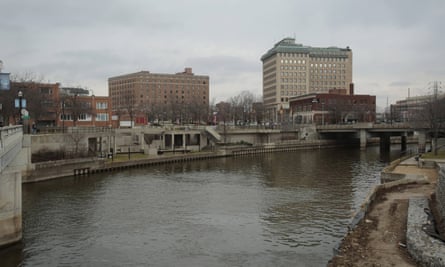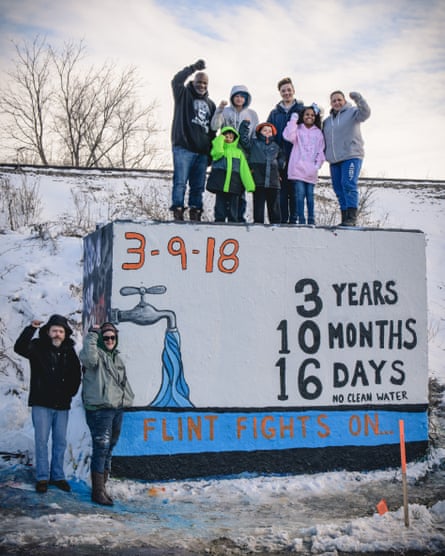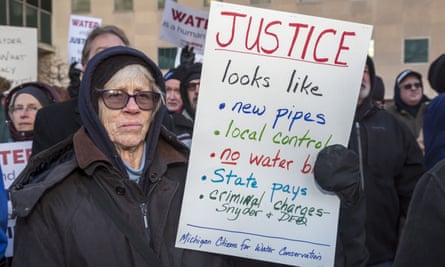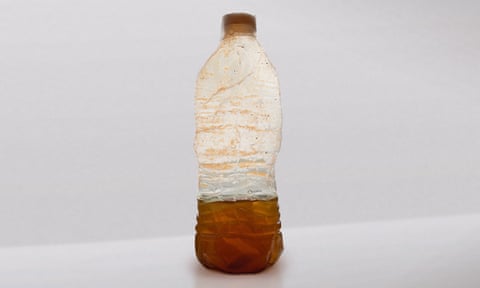On a hot day in the summer of 2014, in the Civic Park neighbourhood where Pastor R Sherman McCathern preached in Flint, Michigan, water rushed out of a couple of fire hydrants. Puddles formed on the dry grass and splashed the skin of the delighted kids who ran through it. But the spray looked strange. “The water was coming out dark as coffee for hours,” McCathern remembered. The shock of it caught in his throat. “Something is wrong here.”
Something had been wrong for months. That spring, Flint, under direction from state officials, turned off the drinking water it had relied upon for nearly 50 years. The city planned to join a new regional system, and while it waited for it to be built, it began bringing in its water from the Flint River. McCathern didn’t pay much attention to the politicking around all this; he had enough to worry about at his busy parish.
But after the switch, many of his neighbours grew alarmed at the water that flowed from their kitchen taps and showerheads. They packed public meetings, wrote questioning letters, and protested at city hall. They filled plastic bottles to show how the water looked brown, or orange, and sometimes had particulates floating in it. Showering seemed to be connected with skin rashes and hair loss. The water smelled foul. A sip of it put the taste of a cold metal coin on your tongue.
But the authorities “said everything was all right and you could drink it, so people did,” McCathern said later. Residents were advised to leave the taps on for a few minutes before using the water, to get a clean flow. As the months went by, the city plant tinkered with treatment and issued a few boil-water advisories. State environmental officials said again and again that there was nothing to worry about. The water was fine.
Whatever their senses told them, whatever the whispers around town, whatever Flint’s troubled history with powerful institutions telling them what was best for them, this wasn’t actually hard for people like McCathern to believe. Public water systems are one of America’s most heroic accomplishments, a feat so successful that it is almost invisible. By making it a commonplace for clean water to be delivered to homes, businesses and schools, untold lives have been saved from cholera, dysentery and typhoid fever. In Flint, the water supply was instrumental in turning General Motors – founded in 1908 in Vehicle City, as Flint was known – into a global economic giant. The advancing underground network of pipes defined the growing city and its metropolitan region, which boasted of being home to one of the strongest middle classes in the country.
But in the latter part of the 20th century, GM closed most of its plants in the city and eliminated almost all of the local auto jobs. Smaller companies followed suit or simply shut down for good. Between 1998 and 2013 alone, nearly 150 of them left the downtown area. With the shuttered businesses came shuttered houses and schools. More than half the population, which had reached a high point of nearly 200,000 in 1960, disappeared. Some 22,000 people left between 2000 and 2010.
The empty structures they left behind were both disheartening and dangerous, not only because they were prone to break-ins and fires, but also because they literally crumbled on to the sidewalks where people passed by. Civic Park’s tree-lined avenues of historic homes became blighted by vacancy. At the same time, the Flint metro region – that is, the suburbs – grew exponentially. It was a widening circle of wealth with a deteriorating centre.
With so much lost, Flint needed help. An emergency plan. A large-scale intervention of some kind. But in fact the state of Michigan exacerbated Flint’s woes by dramatically reducing the money that it funnelled to its cities. Between 1998 and 2016, Michigan diverted more than $5.5bn in tax revenues – which would ordinarily go to places such as Flint, to power streetlights, mow parks and plough snow – and used it to plug holes in its own budget. At the same time, Flint suffered the Great Recession, the mortgage crisis and a major restructuring of the auto industry.
If you wanted to kill a city, that is the recipe. And yet Flint was very much alive. In 2014, the year of the switch to a new source of drinking water, it was the seventh-largest city in the state. For about 99,000 people, Flint was home. And they did what they could to fill the gaps. When Pastor McCathern and his congregation at Joy Tabernacle realised that Civic Park was not on anyone’s list of priorities, they launched their own initiatives to fix up the neighbourhood. They covered the windows and doors of vacant properties, and paid young men to mow lawns and board up empty homes.
“The community was at one time totally ignored by everybody,” McCathern said. “But because young people stood up, now everybody came on board.” You could feel a shift in the momentum. You could see the change. “It was a different Flint that was coming.”
But on that sweltering summer day, there was that water pouring out of the fire hydrant, as children sprinted back and forth through its spray. Dark as coffee.
This is the story of how the city of Flint was poisoned by its own water. It was not because of a natural disaster, or simple negligence, or even because some corner-cutting company was blinded by profit. Instead, a disastrous choice to break a crucial environmental law, followed by 18 months of delay and cover-up by the city, state and federal governments, put a staggering number of citizens in peril.
In a city with plenty of urgent matters competing for attention – poverty, vacancy, schools, crime, jobs – one thing Flint didn’t have to worry about before the spring of 2014 was the quality of its water. The Detroit water and sewerage department (DWSD) had supplied Flint with good water for nearly 50 years. The big public utility drew from the freshwater of Lake Huron, a lake so deep and fierce that it once swallowed eight ships in a single storm. Flint’s own treatment plant, which it had used to treat its river water before joining the DWSD in the 1960s, sat idle. It remained on hand only because the state required a backup water source for emergencies.
But while the quality of DWSD water was reliable, its cost was not. Residents had urged their leaders to relieve the burden of pricey water. Monthly rates in Flint were among the most expensive in the country, and yet 42% of residents lived below the federal poverty level. And the rates kept rising – a 25% increase here, a 45% increase there. Many residents just couldn’t afford their bills. But at this point it was difficult for the city to do much about it. Its infrastructure was built to serve Flint when it had twice the people it had now; to maintain it, fewer ratepayers had to carry a heavier burden.
The county drain commissioner, Jeff Wright, was fond of portraying the DWSD as a price-gouging monopoly, and he saw an opportunity to develop an alternative. He called it the Karegnondi Water Authority (KWA), using a name for Lake Huron used on many 17th-century maps. This new water authority was just an idea at first, and seen as a negotiating tactic to pressure the DWSD for better rates. But then the not-yet-existent KWA got a permit from the Michigan department of environmental quality to pull 85m gallons of water per day out of the Great Lakes. Flint and its neighbouring communities were invited to help build the new water system from the ground up.
Unlike the Detroit system, which delivered treated water, the KWA would pump raw water to the communities it served. That meant they would have to treat the water first, before selling it on to residents and businesses. For Flint, it would mean rebooting the old treatment plant and navigating the complexities of water chemistry in-house. It’s fairly unusual nowadays for a public water system to be built from scratch. That’s especially true if the water source hasn’t run out or become toxic. But Wright, the eventual head of the KWA, lobbied fiercely for it, on the grounds of savings, independence and stability.
Michigan’s state treasurer approved the change (even though it meant that Detroit’s water department would lose the revenue of its second-largest customer just as that city was about to declare bankruptcy). In 2013, Flint contracted with the KWA to purchase 18m gallons of water for the city per day. But construction on the KWA’s new system hadn’t even begun, and it wouldn’t be able to deliver water for at least a couple of years.
Until it was ready, the other communities that were moving to the new system simply paid the DWSD for continuing water service. Flint, however, made the unusual decision to enlist a different source of water during this transition period. The city turned to its emergency supply: the Flint River.
The Flint River was not an obvious choice. It had borne so much mistreatment from industry and development –chemical dumping, sewage effluent – that locals had learned to avoid it. After a series of floods in the early 20th century, massive concrete barricades were built to channel the downtown section. They were meant to make the riverfront safer, but became a fortress line that barred people from the water. Several small dams restricted the river’s navigability. While deindustrialisation and the rise of environmental regulations had vastly improved the water quality, the community still eyed it with suspicion. Generations of kids were taught to fish in the Flint River, casting lines off the grassy banks in their neighbourhoods, but invariably learned to toss the catfish and carp back into the current. They were told it was too dangerous to eat anything from the water.

To treat the river water, the old plant needed a series of upgrades. But getting the facility up to speed was difficult, and while cost estimates varied widely, only a fraction of the early figures proposed by engineering consultants was spent on the project.
The month of the water switch, Flint’s utilities administrator, Michael Glasgow, didn’t believe the plant was ready. He emailed three people at the Michigan department of environmental quality (MDEQ) with a warning. “I have people above me making plans” to distribute the water as soon as possible, Glasgow wrote, but “I do not anticipate giving the OK to begin sending water out anytime soon. If water is distributed from this plant in the next couple of weeks, it will be against my direction. I need time to adequately train additional staff and to update our monitoring plans before I will feel we are ready. I will reiterate this to management above me, but they seem to have their own agenda.”
But the switch was carried out anyway, marked by a toast as local leaders raised their water glasses at the plant. Among the people celebrating was Darnell Earley, the latest in a string of emergency managers appointed by the state of Michigan from 2011 onwards to lead Flint out of financial distress. The idea of emergency management is that an outside official unconstrained by local politics or the prospect of a reelection bid will be better able to make the difficult decisions necessary to get a struggling city back on solid ground. In Flint, that meant that the authority of the mayor, Dayne Walling, and the council had been suspended for more than two years. Their roles were now symbolic and advisory, or empowered (and paid) only to the extent that Earley allowed.
Earley supported the move away from Detroit’s water system. “The city has had virtually no control over managing its most important resource and service,” he argued. This was echoed by an editorial in the local press that heralded it as a way for the city to reclaim its sovereignty, which had been undermined by disinvestment and emergency management.
Stephen Busch, a district supervisor from the MDEQ’s drinking-water office, was also at the water plant the morning of the switch. Earlier, he had expressed worry about what would happen if Flint used its own river for drinking water – bacterial problems, dangerous chemicals, additional regulatory requirements. In other words, the state’s environmental agency had thought that the city should avoid the Flint River. And now Flint was using the river anyway. But at the plant, he seemed tranquil. Regarding the drinking water, he said: “Individuals shouldn’t notice any difference.”
By late May, a month after the switch, the water coming out of the tap in Bethany Hazard’s home in west Flint seemed murky and foamy. She had survived cancer twice, forcing her into early retirement, and she lived on a limited income. She paid about $90 a month for her water and sewer bill, but nonetheless she started buying bottled water. The new tap water, she told a reporter from the Flint Journal, was “just weird”.
Another resident, Lathan Jefferson, was so troubled that within weeks of the switch he contacted officials at the Environmental Protection Agency (EPA). The manager who took his calls, Jennifer Crooks, described them in an email to her colleagues: “Mr Jefferson said he and many people have rashes from the new water. He said his doctor says the rash is from the new drinking water, and I told him to have his doctor document this and he can bring it to the attention of the MDEQ, since lab analyses to date show that the drinking water is meeting all health-based standards.”
By 2 June, less than five weeks after the switch, one local TV station reported that many residents were “avoiding the tap” and “drinking bottled water instead”. “I don’t know how it can be clean if it smells and tastes bad,” a middle-aged resident told a reporter.
Asked to respond, the city said the water met all safety requirements and that it was continually monitoring for problems. “City officials also say the water is perfectly safe for everybody to drink,” the reporter told viewers.
But in fact there was a problem. A serious one. Flint’s new water treatment programme did not include corrosion control. The staff at the plant had been told by the MDEQ that it wasn’t necessary. But this was breaking federal law. In the years to come, the question of whether the authorities omitted this knowingly or through a terrible misunderstanding of the law would be a matter of intense dispute. What’s more, the upgrades to the old plant were not sufficient to deal with river water, which was more corrosive and difficult to treat than lake water. Together, this was a dangerous combination.

Because the US’s infrastructure is generally quite old, large systems are required to add corrosion control treatment to the water to keep the pipes from disintegrating. It extends the life of the pipes and, because it prevents metals from fouling the drinking water, it helps protect public health as well. In about half of all American water companies, including the Detroit system, orthophosphates are added to the water at the treatment plant. These create a protective coating that helps keep metals from leaching into the water as it flows through the water mains and the service lines running to individual houses.
The brown water that gushed from the Civic Park fire hydrants, dark as coffee: that was corroded iron. Flint residents did not yet know all this. But they did know that the water stank.
Meanwhile, public figures spent the summer counselling residents to have patience as they worked out the kinks. “It’s a quality, safe product,” said Mayor Walling. “I think people are wasting their precious money buying bottled water.”
And yet, before the end of the summer, the city issued three separate boil-water advisories in 22 days. These relatively common notices come when there is a system disturbance that could affect water quality, such as a drop in pressure caused by a broken main or maintenance work. But in Flint, which was already uneasy about this expensive and strange-tasting water, the advisories did not seem ordinary at all.
The first notice came on 16 August after faecal coliform bacteria, also known as E coli, had been detected. It was a surprising discovery. Across Michigan, the bacteria show up in drinking water about three times a year on average, and sometimes not at all. Its presence suggests that the water is contaminated by human or animal faeces, which can make people ill, especially older people, young children and those with weak immune systems. The advisory covered half a square mile on the city’s west side. Everybody with a tap was told to boil water for one minute before drinking, bathing, brushing teeth, washing dishes, cooking or making ice.
Each advisory reached farther into Flint. There was no doubt that it was a sign of system weakness, Darnell Earley acknowledged, but it was not “an actual threat to citizen safety”. A reporter from the Flint Journal ran that claim by an engineer at MDEQ and a water expert at Michigan State University. Both agreed that the advisories were a red flag but did not pose an inherent danger to residents. As a fix, the city announced that it would increase the disinfecting chlorine treatment and flush the system in the advisory areas.
It was all very confusing. Officials had conflicting explanations about what caused the E coli contamination in the first place. There was agreement on one thing, however: the water leaving the treatment plant met the standards of the Safe Drinking Water Act. People could drink it without worry.
Around the time of the boil-water advisories, workers at a General Motors plant in Flint noticed rust forming on engine crankshafts and blocks. Suspecting the new water supply was causing the problem, GM experimented with a costly reverse-osmosis technique to purify it. The company also tried diluting it with water trucked in from Detroit. But nothing worked. In October, a little more than a month after the boil-water advisories, GM announced it was hooking up to a neighbouring suburb’s water supply, one that still used Detroit water.
The headlines – “General Motors shutting off Flint River water at engine plant over corrosion worries” – triggered alarm. The day she heard the news, Jan Burgess, a legally blind homeowner in her early 60s, complained to the EPA through its website. “People in Flint have had to resort to buying bottled water or having purification systems installed in their homes,” Burgess wrote. Some had private wells dug. “The water is not safe to drink, cook, or wash dishes with, or even give to pets. We worry every time we shower. The city of Flint is still very economically depressed and most citizens cannot afford anything other than to use the river water.”
The anxiety reverberated all the way to the state capital, Lansing, where Governor Rick Snyder was weeks away from winning reelection. His chief legal counsel, Michael Gadola, wrote in an email: “To anyone who grew up in Flint as I did, the notion that I would be getting my drinking water from the Flint River is downright scary. Too bad the [emergency manager] didn’t ask me what I thought, though I’m sure he heard it from plenty of others. My mom is a city resident. Nice to know she’s drinking water with elevated chlorine levels and fecal coliform … They should try to get back on the Detroit system as a stopgap ASAP before this thing gets too far out of control.”

But that didn’t happen. Earley, Flint’s emergency manager, argued that it would be too expensive to go back on the Detroit system, and that any problems at the plant were fixable. He had no expertise in water treatment, of course; he was relying on the district engineer for the MDEQ. Rust was spreading like a stain on GM’s machinery, probably due to high chloride levels in the water, but the engineer said the chlorides were well within the limit set by public safety regulations.
Whatever the reason for the rust, GM workers were unsettled. They didn’t just use the water for manufacturing. They had used it to brew coffee and wash their hands, take showers and sip something cool when they were thirsty. At school, their children sipped from the drinking fountains. At the GM union, members and retirees were beginning to ask, “If it’s too corrosive for an engine, what’s it doing to the inside of a person?”
On a January evening in 2015 that was cold enough to make your eyes water, hundreds of people packed into the fellowship hall of Antioch Missionary Baptist Church, a large brown building less than a mile from the Flint River. It was standing-room only. Some people kept their winter jackets and hats on. Mayor Walling was there, as well as the public works director and members of the city council. They settled in to hear the stories of their constituents, some of whom shook with anger or wept. Only hours before the meeting, there had been another protest downtown, one of several in the past week. Winter weather seemed to deter no one from outdoor demonstrations. People needed to be heard.
There was more news about the water. The city had been informed that its water violated the federal limit for total trihalomethanes, or TTHMs – four colourless, odourless chemical compounds that are a byproduct of the chlorine disinfection process. When ingested over many years, TTHMs can increase the risk of cancer and cause liver, kidney and nervous-system problems. It was a violation of the Safe Drinking Water Act, and so, as required by law, a notice was mailed to Flint residents on 2 January. They were told that steps were being taken to fix the problem, including the installation of a TTHM monitor and a charcoal filter at the treatment plant. “This is not an emergency,” the notice repeated several times.
At the same time, though, the elderly and people with compromised immune systems were advised to talk to their doctor about drinking the water. This satisfied no one. The executive chef for Flint’s public schools had long since started buying water in bulk for the food served to students. People traded hair-raising stories. A 20-year-old who lived on Flint’s east side said that a few hours after he drank two glasses of water, he was retching over a toilet. “I was throwing up like bleach water. It came up through my nose burning,” he told a reporter.
A week after the gathering at the church, there was another meeting about the water, this time in the domed auditorium of city hall. A panel of experts spoke to a crowd of about 150, some of whom had tucked bottles of discoloured water in their bags and coat pockets.
“Is there a risk in the short-term?” the MDEQ’s Stephen Busch asked attendees. “That depends on you … it’s an individual thing. You can make a judgment after talking to your doctor.” At the same time, Busch said that the water was both good to drink and improving.
In other words, the water isn’t a risk to your health – unless it is. Furious people shouted back. Others walked out in frustration. One woman reportedly tugged down her trousers to show the authorities the red rash on her buttocks. Before answering all the questions submitted in writing, the public works director brought the unruly meeting to an end.
Flint, through emergency management, might have been suffering a deficit of democracy, but its people found other ways of standing up for their community. The city’s culture of organising had been passed down through the generations. The United Auto Workers began their historic sit-down strike in Flint. Frustrated with stunted wages, dangerous conditions and the company’s efforts to intimidate them from forming a union, workers occupied two auto plants on 30 December 1936. Refusing to leave or work, they staged concerts and lectures, while supporters delivered food and picketed outside. The strike spread to a third plant in February. With workers staying inside, it was impossible for the company to hire replacements and get the lines moving again. GM tried turning off the heat to freeze the strikers out, but they remained, burning burlap to stay warm. It took 44 days, but GM eventually announced a $25m wage increase and recognition of the union’s right to organise – a first for the US’s auto industry.
A few decades later, citizens banded together against racial discrimination in real estate in Flint, which was the most segregated city in the north. They held a sleep-in on the lawn of city hall and a rally that drew thousands. In 1968, Flint became the first city in the US to pass a fair housing ordinance by popular vote.
So it was no surprise that when they knew the water switch had gone poorly, the people of Flint got organised. Besides protests, petitions and public meetings, they kept meticulous notes, collected samples, hosted makeshift water distribution sites, created social media pages to share information and sought public documents. Residents also enlisted environmental justice experts from around the country for insight.
In the spring of 2015, a number of groups formed the Coalition for Clean Water to better coordinate their activism. They met in a church basement. After some residents received disturbing results for lead tests, the coalition canvassed homes, distributing information about the dangers. And after yet another emergency manager overruled the council’s vote to get Flint off the river water as soon as possible, the coalition sought an injunction to force action (an effort that died in the courtroom). The organisers also repeatedly made the hour-long drive to Lansing to make their case to the governor’s aides and the MDEQ, and partnered with activists in Detroit who were facing escalating water shutoffs in their own city. Together they led the Detroit to Flint Water Justice Journey, a 70-mile march that told the intersecting stories of each city. In short, the organisers did everything they could to make their plight – their city – visible.

The dogged work of the community is what finally forced a reckoning over Flint’s water. That included the resident who reached out to the EPA official, who, after conducting a series of tests at her home, issued a memo that sounded the alarm over lead in Flint’s water. And that included the members of the Coalition for Clean Water who worked with outside researchers to conduct a citywide test of Flint’s water. It confirmed what should have been obvious: when corrosive water moves through lead pipes and plumbing, and isn’t treated with corrosion control, a lot of lead ends up in the water. That’s especially true if the pipes are old, leaky, oversized and cross long stretches of vacant land. In Flint’s case, water samples were well over the federal action level for lead, and nearly three times over the safety level set by the World Health Organization.
The series of problems with the water were connected. Rapidly corroding iron negated the chlorine treatment. Without the disinfectant, the water was vulnerable to bacteria growth. The first of the E coli bacteria violations had come a few months after the switch. To combat it, more chlorine was added to the water. But this contributed to the spike in TTHMs, the disinfectant byproduct. As the corrosion worsened, lead leached into the water. No amount of lead exposure is safe, and there is no known cure for lead poisoning. The excess iron also turned out to be a perfect nutrient for the growth of other types of bacteria, including legionella, which causes a virulent form of pneumonia called Legionnaires’ disease. Over two years, an outbreak of the disease affected at least 90 people and killed 12. And, according to one research team, the water switch correlated with a serious drop in fertility for women in Flint and a 58% increase in foetal deaths.
When residents noticed there was something odd about their water, they asked for help. They organised. They made themselves seen. But they were routinely dismissed. Among the many ravages attributed to the water crisis – the rashes, the hair loss, the ruined plumbing, the devalued homes, the diminished businesses, the home owners who left the city once and for all, the children poisoned by lead, the people made ill or killed by Legionnaires’ disease – perhaps the most devastating was that people lost faith in those who were supposed to be working for the common good. That this happened in the Great Lakes State, which is surrounded by one-fifth of all the freshwater on the face of the Earth, makes it all the more haunting.
What happened in Flint reveals a new hydra of dangers in civic life: environmental injustice, the limits of austerity, and urban disinvestment. Neglect, it turns out, is not a passive force in American cities, but an aggressive one.
The Poisoned City: Flint’s Water and the American Urban Tragedy by Anna Clark is published by Metropolitan on 10 July
